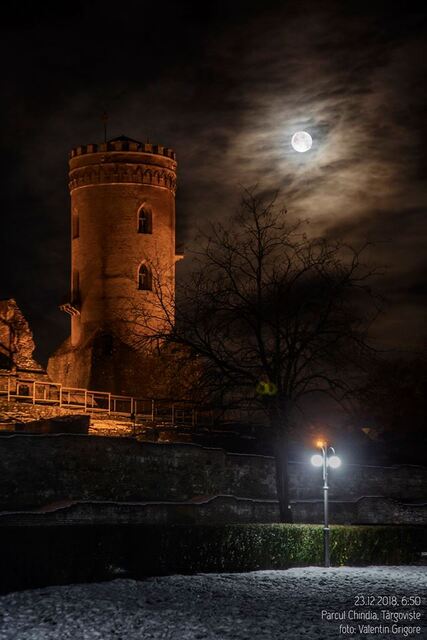FROM DRACULA’S BORGO CASTLE
TO THE TIHUTA CROSS
Introductory photo Valentin Grigore
Text and photos Andrei Dorian Gheorghe
Design Florin Alexandru Stancu-

I think that Tower Chindia in Targoviste, Wallachia, Romania,
made by Vlad Tepes Dracula in the 15th century
(and photographed by the president of SARM, Valentin Grigore,
under the Crowned Moon in 2018 December 23)
should be the main symbol of the existence
of this controversial “voievod” and “domnitor”.
Thus, from here,
he observed the movements of the Ottoman army in 1462
and prepared a devastating night attack
in which he tried to kill Sultan Mehmed II,
the conqueror of Constantinople in 1453.
But history was rather ironical:
posthumously, Vlad the Impaler became even more famous
due to a horror fantasy of an Irish writer,
who has a statue erected at a distance of around 400 km,
in the Borgo Pass, Transylvania, Romania.
Bram Stoker wrote and published the Dracula novel
in 1897.
The success was so big that, 100 years after,
the Horror Writers Association inaugurated the annual Bram Stoker Award.
In fact, Bram Stoker (inspired from South-East-European traditions
and pages written by Saxon colonists from Transylvania,
who had been in commercial and military conflicts with Wallachia
in the 15th century)
wrote a fiction, inventing a vampire character,
Dracula, Count of Bistritz,
who lived in a castle at the border between Transylvania and Moldova,
in the Bargau (Borgo) or Tihuta Pass.
The problem is that, historically,
Dracula was the second nickname of Vlad Tepes (the Impaler),
a real “voievod” and “domnitor” of Wallachia,
who has remained in Romanian national memory
as a cruel champion of justice and a brave defender of Christianity .
So that various opinions have appeared about the opera of Bram Stoker,
from those who consider that he insulted the Romanian nation
to those who admire him just because he created
a well-known commercial brand for Romania.
One after the other, in 2018-06-22
I had the chance to go from Bistrita
(the former Capital City of Nosnerland or Bistritz,
a district governed by Saxon colonists as Royal Guests of the Hungarian Kings
over the local Romanians
in between the 12th century and 19th century)
to the Tihuta (Borgo) Pass.
On the road I remarked
a veritable collection of Saxon and Romanian traditional houses.
The Tihuta Pass (around 1200 m altitude) charmed me
through beautiful landscapes,
signifying the resistance of green nature.
Here, during the totalitarian regime,
a zonal director in tourism who had read Stoker’s novel
courageously proposed in 1976 the construction of a castle-hotel.
Surprisingly, the Communist Party
(otherwise, very rigid with such ideas)
approved the proposal,
and the building was ready in 1983.
After 1990, when Romania re-became a free state,
many tourists visited the castle-hotel,
which is decorated inside with more paintings
inspired from Stoker’s novel,
and has become a pilgrimage place for the members
of the Dracula Society (from London).
As a sky lover,
I remarked especially three paintings
with three young women (Dracula’s Brides?) under the Full Moon,
and one with a varcolac under the Full Moon,
and I thought of the Romanian traditions in which
the varcolacs are a superior form of the vampires
and bite the Moon, provoking eclipses.
As a kind of compensation,
a monastery can be seen on a close top,
reminding of the fact that, in reality,
Vlad Tepes Dracula built a few Orthodox-Christian churches
(too much for a potential vampire, I think).
In fact, I would say that Vlad Tepes Dracula was rather an anti-vampire
just because he fought against Ottoman invaders,
who morally were real vampires for the Romanian people.
The Tihuta Monastery was founded in the 1920s as a chapel,
and was extended after 1990 as a monastic complex,
including a spectacular cross (35 m high,
included in top 20 of the tallest crosses in the world).
Suddenly, after I left the castle-hotel,
I saw a car stopping right under a patch of bloody sky.
It may be just Dracula,
I said and I ran far away.
But… who of them?
Dracula’s case, eternal friction
Between reality and fiction.
The Voievod and Domnitor of Wallachia?
Or… the Count of Bistritz?
*
© 2019 SARM
(Romanian Society for Meteors and Astronomy)